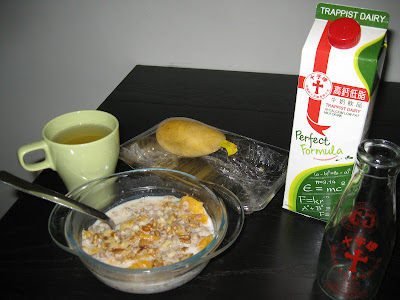Man Mo Temple is probably the oldest temple in Hong Kong, and it's less than a half-hour's walk from our apartment. We live in the Sai Wan ("western bay") district and the temple is located in Sheung Wan ("upper bay") just to the east. Man Mo is very close to Possession Street, which supposedly marks the place where the British first claimed Hong Kong Island as theirs in 1841. The Man Mo temple complex was built over a 15-year period, beginning in 1847. Why would a Chinese temple be built in the area where the British had planted their flag only a few years earlier? I finally came across an explanation today.
When the British began sailing here and colonizing Hong Kong Island after it was ceded to the British empire in 1842, they settled in the Chung Wan ("central bay") area, now called simply Central. They particularly liked living on Victoria Peak uphill from Central because it was cooler during the steamy Hong Kong summers. Because they wanted to settle in these favorable areas themselves, they forced out any Chinese who were living there. These displaced Chinese settled in the Sheung Wan area. To this day, many parts of Sheung Wan retain a very Chinese flavor. Besides Man Mo Temple, there are numerous shops nearby that sell Chinese herbs and medicines, dried fish, tea, incense and paper offerings for Chinese celebrations, and lots of traditional Chinese restaurants and dai pai dongs, small informal food stalls with that often feature rickety tables and stools under an awning.

Man Mo Temple is located on Hollywood Road. In an earlier post I'd written that this street got its name from holly bushes that used to grow here, which I'd read in a guidebook. I have since read that Sir John Davis, who governed Hong Kong in the 1840's, named this street after his family home in England. Terry knows this street well. He walks the whole length of it from Queen's Road West until it turns into Wyndham Street, where his office is located. I've walked by Man Mo Temple on Hollywood Road a number of times. Today, though, I decided to go in.

Man Mo is dedicated to two deities: Man, a civil deity who's worshipped as the god of literature, and Mo, the god of war, who's the patron god of restaurants and the police (those are some very curious connections). The temple also honors the god of justice, the god of the city and the goddess of mercy. I saw very little signage in English outside the temple. Not knowing what was located where inside the complex, I picked the door right in front of the entrance and walked into this middle building.
I had actually gone into the temple with a specific mission today. I'd had a request to light two joss sticks for a friend for good luck, if I should go into Man Mo. There were several altars in this middle building with various deity figures, and people had left many offerings of fruit and flowers, besides lots of joss sticks stuck in urns of sand. There were a number of huge burning coils of incense hanging from the ceiling. Burning incense is one of my less favorite smells, so I decided I needed be efficient with my mission. I needed some help.

There were several people in the temple, all of them with burning joss sticks, some of them bowing several times in front of the altars before they placed the sticks in the urns of sand. I approached the woman in the orange shirt and asked if she spoke English. Some, she said. I told her a little about myself, told her about my friend's request and asked if she could suggest which of the several altars would be the best one. She pointed to the one right in front of us.
The woman in white agreed. She added that she was coming to Man Mo as a tourist, too, that she'd been born in Hong Kong but has been living in the U.K. for the last 35 years. She told me that her mother had said that the altar in front of us was for a "caring" deity and that this was where she was placing the joss sticks in her hand. So I may have found the altar for Kwun Yurn, the goddess of mercy that I'd read about.
Two of the burning joss sticks below are mine. You can also see the incense coils on the ceiling.
Mission accomplished.
















